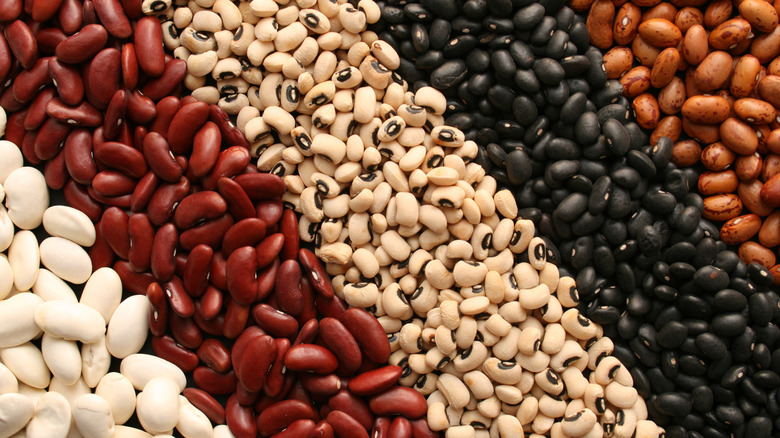Are Beans And Legumes The Same Thing?
Here at Chowhound, we're often trying to nail down the difference between similar culinary products, like turnips and kohlrabi or pepitas and pumpkin seeds. Well, there's yet another case of mistaken identity that we need to lay to rest: beans and legumes. The casual home chef may not know how to explain the distinction between a bean and a legume, especially when the terms seem to always be linked to one another.
So, are beans and legumes the same thing? The answer is complicated. While the two are botanically similar, a bean actually falls into the subcategory under the legume family. Legume is an overarching term that feature many different food groups, including soybeans, peanuts, green peas, and green beans. Also underneath this legume umbrella is the category of pulses, basically the dried edible seeds of the legume, which is where starchy kidney beans, black beans, pinto beans, etc. finally land. Other common pulses are lentils and chickpeas, more classic soup thickeners. Long story short, while all beans are legumes, not all legumes are beans.
Incorporating beans and legumes into your diet
Not only are beans delicious, but they are also usually cheap and extremely easy to prepare. While all legumes will provide a different type of nutritional benefit, certain types of pulses like chickpeas, lentils, and certain beans — kidney and black bean varieties are two standouts — have proven to be the best source of fiber, protein, and nourishing nutrients. While all of this information may be overwhelming to a prospective bean enjoyer, there are so many ways to slowly introduce your body to a more bean-heavy diet.
First, consider turning to cuisines that have a long-standing history of using beans as a staple ingredient. Caribbean, Latin American, and South American cultures have all relied on various types of beans as a major nutrition source, transforming them into delicious fool-proof meals. For instance, make a batch of Cuban black beans as an aromatic introduction into the pulse's culinary potential.
Alternatively, think outside the box and try a legume-heavy dessert. Many vegetarians have already discovered the versatility of the black bean, but some have also opted to bake black bean brownies, a delicious gluten-free dish that provides more fiber than an average brownie recipe. You can also ease your way into a bean-balanced diet. Some professionals urge new diners to shift into the bean community by trying out lentils first, since their preparation is much easier. A lentil soup is a great place to start. From there, you can experiment with pared down bean-based snacks, like white bean dip or black bean-style hummus.

